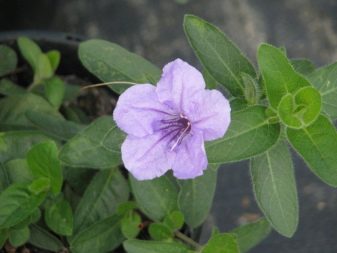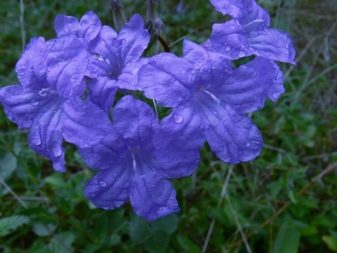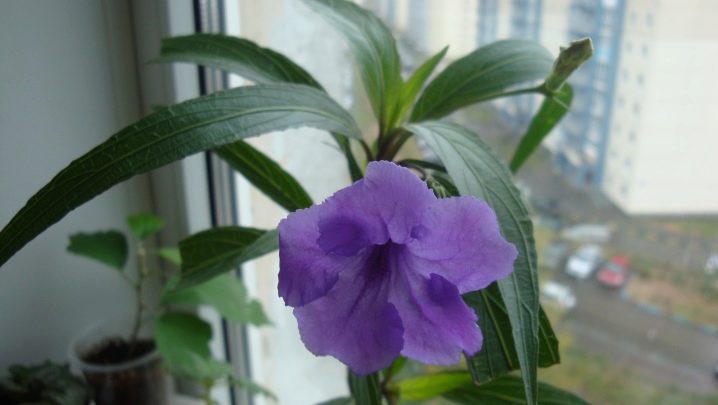Ruellia: description, types and care at home

Ruellia is rarely found in flower shops, and yet this flower is loved by many for its velvety flowers and expressive, beautifully outlined leaves. The discovery of this plant belongs to the French scientist Jean Ruel, after whom the flower was named. You can also find other names: Mexican petunia and dipteracanthus.

Peculiarities
Ruellia is very fond of a warm climate and moisture, therefore, in its natural environment, it is found in warm regions: Africa, South Asia and some regions of America (tropics and subtropics). This crop is grown as a herbaceous plant, and there is also a shrub variety. The description says that such a plant is characterized by different types of stems: straight, creeping and gentle. The stems have several edges and are characterized by good branching. The leaves are solid, slightly elongated, with an expansion in the middle. There are plants with glossy and velvety leaves.


The flowers are single and rather large for such a plant (up to 5 cm), appear at the ends of the shoots. Depending on the variety, dipteracanthus can be covered with white, blue, pink with a purple tint or beige. They quickly fade and fall off; the life of a flower is usually several hours. Due to the large number of flowers, ruelia blooms continuously. After a while, a seed box appears at the location of the flowers. When ripe, it bursts, and the seeds fly out of it, spreading over a long distance.


The flowering of the plant can last from February to December, if it has enough light and heat. With a lack of light, the flowering period is reduced to several months. One of the main features of this plant is its ability to bloom in winter, when most of the flowers are dormant. You can buy ruella from florists who breed this indoor flower. In stores, however, it is very rare.


Varieties
There are about 200 varieties of this plant. Not all of these species are suitable for home growing. The most interesting are the following subspecies.
- Ruelle Britton. It is an evergreen shrub. Its height can be up to a meter. The stems lumber at the base, the leaves are long and wide. The shrub is covered with large, purple flowers. This type of ruella is unpretentious to the conditions, therefore it is happily grown in apartments.


- Dipteracanthus Devos, blue ruella or Devo. It grows in South America in tropical forests, which are characterized by high humidity. The height of the plant can reach up to 40 cm. The foliage has the shape of an ellipse, the velvety leaves grow up to 7 cm long. The leaves are two-colored: on the upper side they are green, and on the back - purple with white veins. Single, light lilac flowers appear in the axils of the leaves.


- Dipteracanthus Portella. This species also loves the climate of tropical South American forests. This plant is similar in appearance to the previous species. The differences are in larger leaves with a brownish tint and in bright pink colors.


- Ruelia grandiflorum is a perennial shrub that grows up to 2 meters.The leaves are characterized by an elliptical shape, their length varies between 10-15 cm. The corolla has a tubular shape, which is characteristic of bells. Flowers can be called large: width 8 cm, length - 12. Flowers are formed at the tops of the shoots. There are three options for their color: red, pink and lilac. If additional lighting is provided, the ruelia will bloom throughout the fall and winter.


- Ruelle Caroline is a creeping plant. The stems of such a plant are strongly pubescent, the leaves stand out in a dark green color with lettuce veins. The flowers are painted in a delicate lilac shade.


- Dipteracanthus Makoya attracts with its striking appearance, which is of decorative value. Bushes can grow up to 60 cm, they are erect, with strong branching. On the elongated leaves, yellow stripes on the veins are clearly visible. The length of the sheets varies between 6-8 cm, purple villi are present on the underside. The variety stands out for its large, burgundy flowers.


Conditions of detention
Ruellia, although it is considered an unpretentious plant, but however, certain conditions for its content must be respected.
- For the location of the Mexican petunia, the western or eastern side is chosen. This flower loves fresh air, but reacts negatively to drafts. In summer, the pot can be taken outside, but protection from direct sun must be provided.
- There should be enough light, but the sun should not be allowed to shine directly on the plant. In winter, additional illumination is required, which will increase the daylight hours to at least 12 hours.
- For the period of growth and flowering, it is necessary to provide an air temperature within 22-25 degrees. During the rest period, the temperature can be reduced by only a few degrees. The critical level is at around 18 degrees. Only the large-flowered variety can tolerate 15 degrees.
- Air humidity needs high - 80% and higher. The plant needs regular spraying and wiping of the leaves, you can do a warm shower. To maintain high humidity, wet peat, expanded clay or sphagnum can be placed in the pallet. In a hot period, containers with water are placed near the flower. In winter, the plant is removed from radiators and other heat sources. A florarium or a mini greenhouse is a good option.

Planting and transplanting
A Mexican petunia transplant should be carried out every year - this applies to a young plant. After they reach the age of three, the frequency of transplants may decrease. Better to do this in March. Ruelia has high demands on the soil, so this issue should be taken seriously. The plant is categorically unsuitable for heavy, clayey soil, which does not allow air to pass through well. You can buy ready-made soil or make the necessary substrate yourself. For those who choose the latter option, you need to know the proportions of the components for the soil:
- garden land is 20%;
- the same amount of coarse sand or perlite is taken, the latter option is even more preferable;
- peat will need 25%;
- the remaining 35% falls on leafy land.



Land purchased or prepared by yourself must be kept in a water bath for about 10 minutes. Thus, the soil will be decontaminated. If the plant is replanted, then the new pot should be 4 cm larger than the old one.
Now that everything is prepared, you can proceed to transplanting the plant:
- we equip the bottom of the pot with holes for draining excess moisture during watering;
- the first layer is created from drainage material (fine fraction pebbles, vermiculite, expanded clay);
- then a layer of prepared substrate follows - about 2 cm;
- we take the plant out of the old pot and inspect the condition of the roots for rotten or dry elements, which, if detected, should be immediately removed;
- gently shake off the soil from the plant, trying not to damage the delicate leaves and young shoots;
- we place the flower in a prepared pot, straighten the roots and fill the void with soil;
- the plant can be placed with a spacer if you want to form a vertical shape.


How to care?
Caring for ruelia is not difficult, and however, some rules will have to be adhered to.
- When a plant is actively growing and blooming, it needs regular, moderate, but frequent watering. The soil can dry out no more than 2 cm. Watering, as well as spraying, requires the use of warm water. Hard water is not the best option. Optimally use melt / rainwater. If this is not possible, then ordinary water is settled, boiled or filtered.
- It is imperative to feed Mexican petunia, since it spends a lot of energy on abundant and long flowering. It is good to use top dressing with a long-term effect, it comes in the form of sticks and granules. If a liquid fertilizer is chosen, then its solution is used twice a month.
- Growing dipteracanthus at home involves pruning, as it grows quickly and branches heavily. This process is best done with the onset of spring. Old shoots that have shed most of the leaves and give few flowers are initially cut off. Such shoots are cut to the apical bud. Other branches are cut at personal discretion. Short shoots are simply pinched, which will increase the bushiness of the plant.

Reproduction
Ruellia reproduces easily, so no one has any problems with this process. There are several ways that this amazing plant can be propagated.
- Cuttings. It is necessary to choose shoots without signs of woodiness. They are placed in water. After a while, the first roots will appear, which means that you can start planting sprouts. You should choose about 6 sprouts per pot, in this case the flower arrangement will look lush and harmonious.

- Layers. This makes it even easier to propagate ruella. It is necessary to tilt the shoot to the ground so that one of its nodes reaches the ground. In this position, the branch is fixed until the roots appear at the site of the knot. This layer can be detached from the main plant.

- Seeds. And in this way, ruelia reproduces very well. You need to wait for the seeds to ripen, lightly press on the seed pod and collect the seeds that appear. You can soak the seeds in a weak solution of potassium permanganate, then plant them in moist soil and lightly sprinkle them with earth.

Diseases and pests
Ruellia is characterized by high immunity, therefore it is rarely affected by pests and is sick. And yet, the plant cannot resist the spider mite and whitefly. The mite infects ruella throughout the year, and the whitefly appears more often in the summer. If the conditions of detention are violated: the humidity rises and the temperature drops, then gray rot and powdery mildew may appear on the plant. You can fight such pests with any insecticide that is suitable for these purposes.

Ruella starts to get sick from unfavorable conditions of detention. You can find out about the problem by the following signs.
- Leaves become stained and curled under excessive light, direct sunlight and high temperatures. To fix the problem, you can create a shade or move the plant to another, more suitable place.
- Drying of the leaves indicates insufficient moisture. In this state, the plant will not bloom.
- If the shoots are stretched, the leaves are small, and the plant itself is inconspicuous, then we can talk about a lack of light. It is necessary to install special lamps or find another, more illuminated place for the ruella.
- Falling yellow leaves will indicate a draft or over-watering.
- The growth of ruelia is accompanied by stretching of the stems and foliage falling off.In such cases, it is required to update the plant by pruning the shoots.


For information on how to properly care for ruelia, see the next video.























The comment was sent successfully.